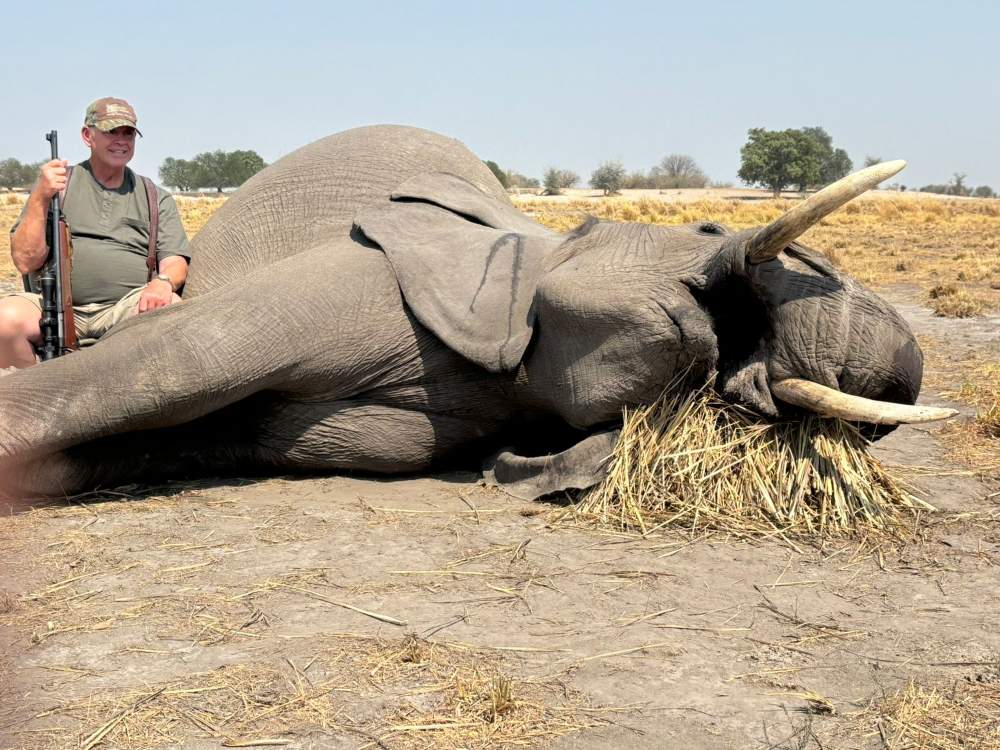This blog is dedicated to an exceptional hunter and conservationist, whom we had the good fortune to meet and spend time with during our recent hunt in Namibia, Paul and his lovely wife Barbara from the U.S.A.
[DYNAMIC-BLOGTABLEOFCONTENT]
Key Takeaways
- The African elephant is still considered one of the most dangerous animals when hunting in Africa and remains a sought-after game hunting
- Namibia has been experiencing its worst drought in more than 100 years, with a state of emergency declared by the Namibian Government.
- The Ministry of Environment, Forestry and Tourism (MEFT) confirmed that more than 700 animals would be culled.
- The culling will take place in various national parks throughout the country, conducted by professional hunters and safari outfitters, with the hunting season for 2024 has been extended until 31st December 2024.
- Game Hunting Safaris, in support of the drought relief hunts taking place in Namibia, booked one non-exportable hippo and one non-exportable Cape buffalo hunt. While on this hunt, the team was invited as spectators on an elephant hunting safari.
- The hunts took place in the Zambezi region, an area rich in natural wildlife and dangerous game, such as Elephant, Hippo, Crocodile, and Cape Buffalo, along with an abundance of plains game such as the Chapmans Zebra.
- Animals harvested by clients of African outfitters, which are non-exportable trophies, are donated to communities that benefit by not only meat proceeds but also a portion of the trophy fee paid by the international hunters.
- The “tortoise” technique of hunting was utilized by the hunters to stalk and approach the target on this elephant hunt.
- A CITES permit is required to hunt elephants.
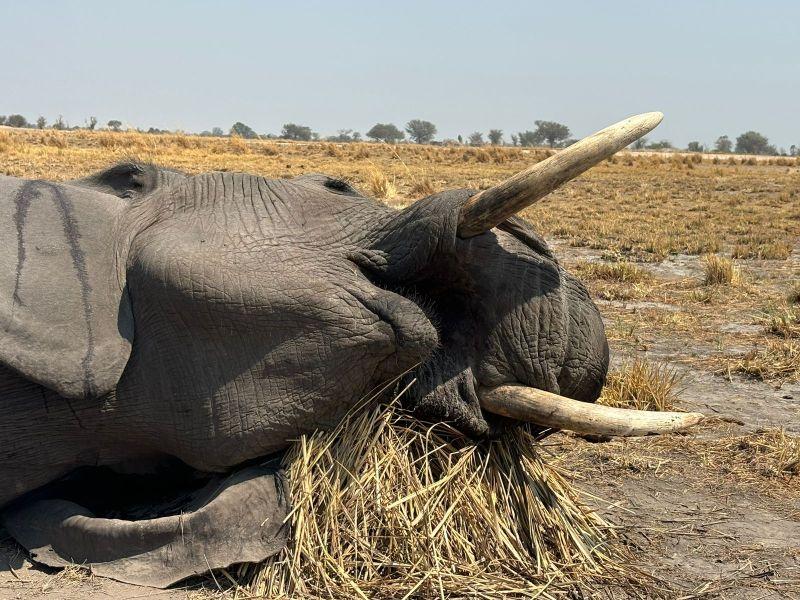
The Might African Elephant: Anatomy
- The African elephant is the world’s largest land animal, with bulls reaching impressive heights of over 10 feet at the shoulder and weighing up to 14,000 pounds.
- Elephants are native to sub-Saharan Africa.
- There are two species of African elephants, namely the savanna (bush) elephant, and the forest elephant. Namibia is home to the savanna elephant.
- These intelligent mammals are not to be messed with, and many hunters have told tales of elephants seeking revenge on hunters after hunting parties had targeted their herd.
- Their gray, tough skin is full of folds and wrinkles, with some elephants using mud to protect themselves from the harsh African sun.
- One of the elephant’s most distinctive features is its long trunk, which is used to bring food and water to its mouth as well as grasping objects.
- Both male and female elephants have tusks, made of ivory, that make them a sought-after hunting trophy to add to any collection. These are used to carry heavy objects, or during fighting to attack and defend themselves.
- An interesting fact is that an elephant, when overheating in the sun and water is not available, can push their trunks down their throats and into the stomach, and suck up bodily fluids to spray over their heads and torso to cool down.
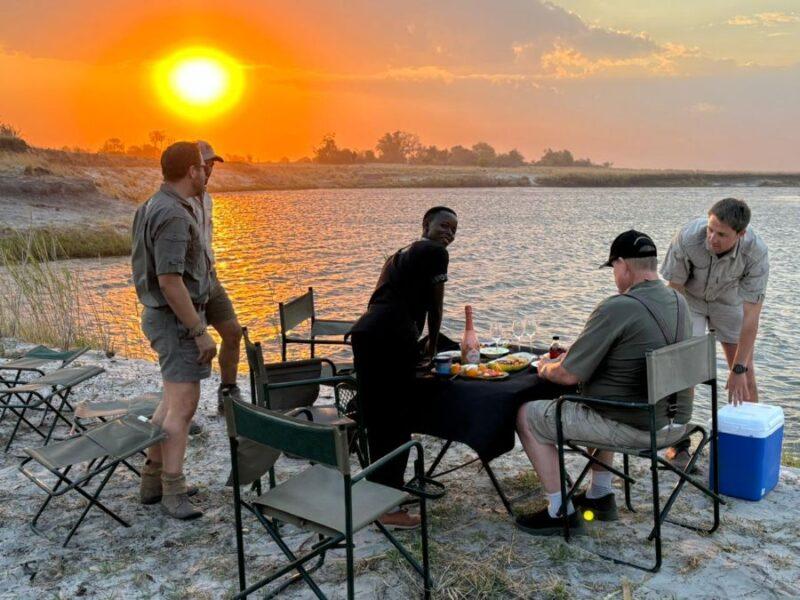
The Zambezi Region
This beautiful region of Namibia, formerly known as the Caprivi Strip, is found in the northeastern region of Namibia. This 5,708 square mile region is bordered by Angola and Zambia to the north, Botswana to the south, and Zimbabwe to the east.
The area abounds with wildlife, including the famous African elephant. Four main rivers run through the Zambezi region, including the Chobe, Zambezi, Kwando, and Linyanti Rivers, providing rich habitats for diverse bird species and wildlife.
From wetlands and floodplains to savannas and woodlands, the area is home to an abundance of wildlife, including elephants, buffalo, hippos, crocodiles, and a wide variety of bird species. Its rich biodiversity makes it a prime location for game hunting safaris, especially with members of the Dangerous 7 thriving here.
The sheer volume of elephants in the area is astounding. Many of these elephants cross the mighty Chobe River from Botswana, the elephant capital of the world with more than 130 000 elephants in the region.
Tourist Attractions in the Zambezi Region
Namibia is often referred to as the “land of sand,” but you would never believe this when setting foot in the lush Zambezi region. While a game hunting safari may be your primary objective for visiting the region, the area is a melting pot of activities, cultures, and experiences that are well worth exploring.
Victoria Falls
Only a hop, skip, and jump away, the Victoria Falls in Zimbabwe is a great day trip reachable from the Caprivi region. Also known as “The Smoke that Thunders,” this natural wonder is over 5600 feet wide, with the falls dropping 262-354 feet into the Zambezi Gorge.
From the Zambezi region in Namibia, it is approximately an hour’s drive to the crossover point on the Chobe River into Botswana into the town of Kasane. Passport stamping for exit and exiting the countries is a quick process and once you enter Botswana, an independent tour operator will transfer you to Victoria Falls. This transfer is short, taking approximately 45 minutes.
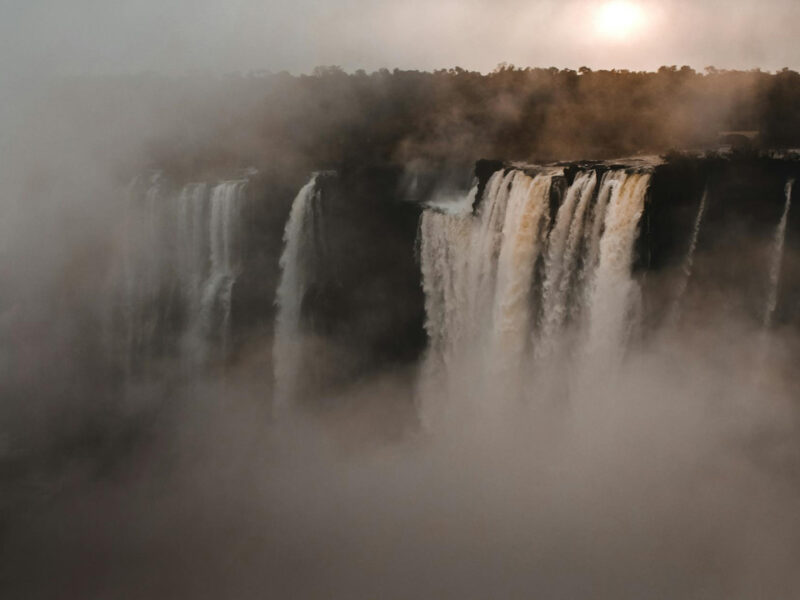
Chobe National Park, Botswana
Just over the Chobe River lies Kasane, a town situated in Botswana, and the gateway to Chobe National Park, another great day trip from the Zambezi region.
Katima Mulilo
Located along the famous Zambezi River, the town of Katima Mulilo provides would-be travelers with the opportunity to experience local culture, with a visit to the Caprivi Art Center. The town of Katima Mulilo by road transfer, while not that far takes approximately one and half hours due to the rugged terrain.
A Visit to local National Parks
Famous for its wide array of species and abundant wildlife, no visit to the Zambezi region is complete without popping in at some of its famous parks, including Bwabwata National Park, Mudumu National Park, and Nkasa Rupara National Park. From game drives and bird watching to serene nature at its best, these parks never fail to disappoint.
Mafwe Living Museum
Located about 20 miles from Kongola, this open-air museum offers visitors the chance to step into the traditional culture and way of life of the Mafwe people. The museum incorporates guided tours, traditional villages, and huts, together with vibrant cultural demonstrations.
Adventures on the Caprivi
No visit to the area is complete without some water activities! Relax in some water-based activities, like fishing, boat cruises, and sunset cruises down the Zambezi River.
An Elephant Hunt: The Ultimate Dangerous Game Hunting Safari
After the completion of our hippo and Cape Buffalo hunt in Namibia, we were invited to join Paul as observers on his elephant hunting safari.
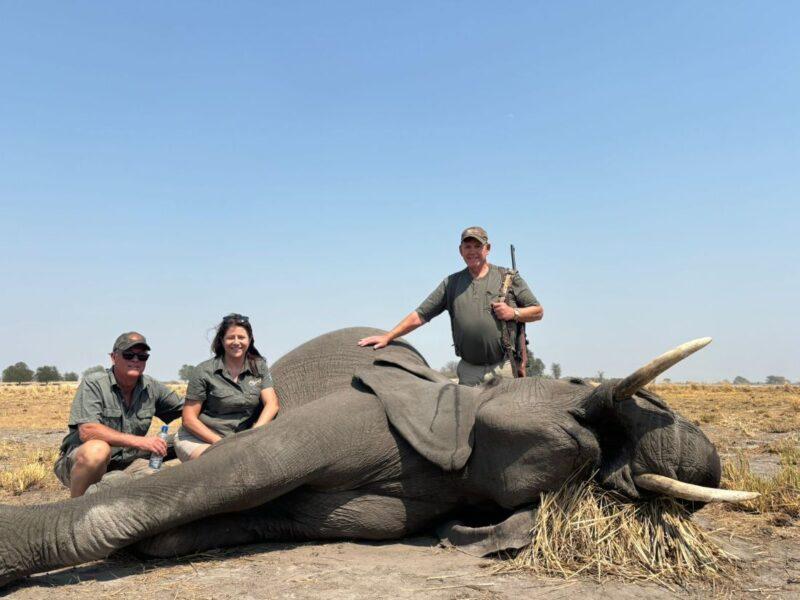
Elephant Hunting Methods on Namibia’s open plains
But how does one get within shooting distance of these majestic animals, that are renowned for their exceptional hearing? Is it even possible, without giving away the entire elephant hunting party?
Yes, it is, using the “tortoise formation” strategy. This clever strategy was utilized, something that before our Cape buffalo and hippo hunting adventures in the Caprivi, we had not come across. This unusual, yet very successful technique has the hunting party all huddling together, arms linked to shoulders in a “tortoise formation” and shuffling forward right in the open, changing the shape of the landscape.
Once every while, whenever the elephants would lift their heads, or show interest in this strange occurrence, the “tortoise” would stop and crouch down, literally vanishing in the open. While the elephants in the Caprivi region may be accustomed to seeing humans and different animals, they were most definitely not used to this “tortoise” and went back about their business, all but ignoring the hunting party that was closing in on them.
At a distance of roughly 60 yards, with the elephant quartering towards the hunting party, Paul took the broadside shot into the elephant, hitting the heart and vital organs ensuring a quick and humane kill. Like on any dangerous game hunt, two or three shots are fired in succession ensuring that the animal is firmly anchored. As is tradition, the hunter cuts off the elephant’s tail, as it is only then that it belongs to him.
When elephant hunting in the Caprivi Strip (Zambezi Regions), ensuring the elephant or any other dangerous game animal is anchored quickly is of vital importance. In most instances, Botswana is only a few hundred yards away across the Chobe River.
An elephant successfully crossing over into Botswana is thus classified “as out of bounds” and the trophy is lost forever.
Pressure to Process: Giving Back to the Local Communities
Namibia is home to one of the best-run and regulated hunting industries in the world. Hunting tourism is taken very seriously, and it is one of the only governments where hunting is mentioned in the constitution. Namibia’s commitment to sustainable hunting is more than just a revenue strategy; it is a constitutional obligation. The constitution includes provisions to ensure wildlife conservation, support local communities, and maintain ecological balance through regulated hunting practices.
In terms of keeping with this obligation, the government will allocate a quota to each conservancy, based on the size thereof. The animals are harvested by clients of the African outfitters. Communities benefit by not only having a portion of the trophy paid by the international hunters but also with meat proceeds.
If you have ever been hunting in Africa, you will know that many, many local communities depend on this meat to provide fresh protein for their people.
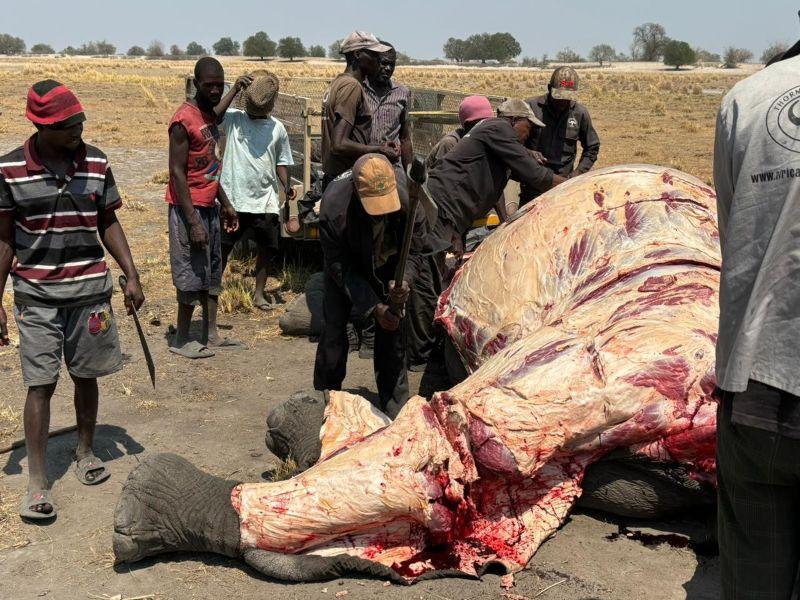
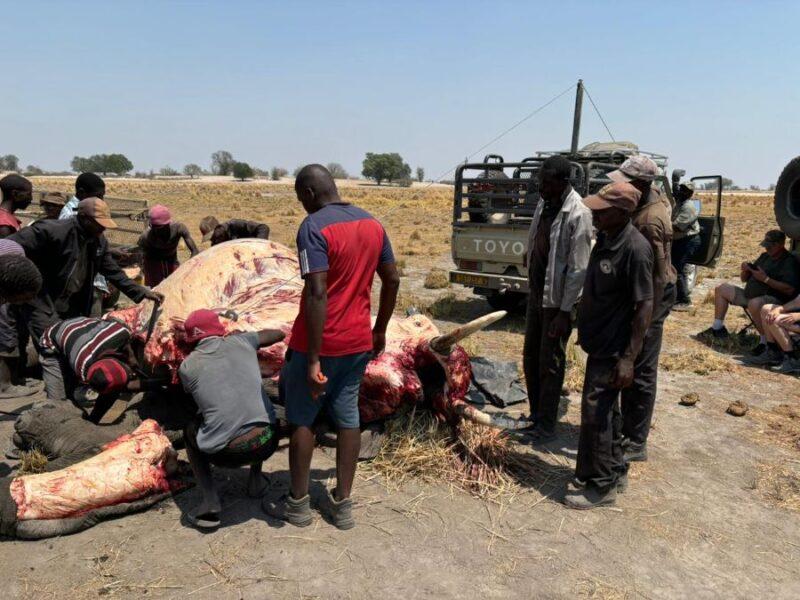
But this comes with its own challenges for the African outfitter, who faces major fines of N$100 000 should the meat not be delivered timeously or the meat spoilt. Working in outlying areas, with the extreme heat that is experienced during the Namibian hot summer months, together with large quantities of meat such as this elephant to keep cool, provides great challenges.
Paul did not only successfully hunt an elephant, but as he mentioned, was humbled by the fact that he had the opportunity to feed hungry residents for weeks to come.
Regular meetings occur with local community members / the conservancy’s committee team to adhere to the concessions agreements and tick the boxes to meet certain requirements and criteria. African outfitters also provide a certain portion of their income to be allocated to basic requirements that can include, amongst others, building basic structures such as schools or clinics, drilling boreholes for freshwater, or providing solar electricity to the area.
As mentioned, every piece of the elephant is utilized. For example, the elephant’s hide is used to make gun bags, belts, duffel, and travel bags, with even the hair used to make beautiful and unusual bracelets.
Frequently Asked Questions
Where is elephant hunting legal?
Elephant hunting is legal in many African countries including Namibia, Botswana, Zimbabwe, South Africa, Tanzania, Mozambique, and Zambia.
Is elephant hunting legal in Namibia?
Yes, elephant hunting is legal in Namibia, with popular destinations within the country to enjoy an elephant hunt including the Zambezi region, formerly known as the Caprivi Strip.
What caliber rifle is used when elephant hunting?
When elephant hunting in Namibia, the minimum caliber is a .375 caliber. This applies to all dangerous game hunting in the region. Some hunters do suggest using a larger caliber, such as a .450 or more, with the recommendation being to use the largest caliber with which you are comfortable shooting on your elephant hunt.
How many elephants are found in Namibia’s Etosha region?
Etosha is home to more than 2,500 elephants.
What is the lifespan of an elephant?
An elephant can live between 60-70 years in the wild, while captive elephants are usually dead before the age of 40 years.
How many types of elephants are there in Africa?
Africa is home to two main species of elephants, namely the African savanna (bush) elephant and the African forest elephant.
What country in Africa has the most elephants?
Botswana is home to the world’s largest elephant population, with more than 130,000 elephants inhabiting the country.
Do I need a permit for elephant hunting in Namibia?
Yes, a CITES permit is required for elephant hunting in Namibia. The Convention on International Trade in Endangered Species of Wild Fauna and Flora (CITES) regulates the trade of African and Asian elephants as well as their parts. Namibia’s elephants are listed in CITES Appendix II, which means that CITES permits are required for elephant hunting.
Conclusion
As a hunting destination, Namibia offers international hunters the best of both worlds: The easy accessibility of a first-world country’s conveniences, while allowing them to experience the Africa of old with unforgettable hunting safaris in lush, unspoiled landscapes. Ask Paul and many others like him, the lure of Africa is real. Can you afford to miss out?

Author: P.C. van Wyk
